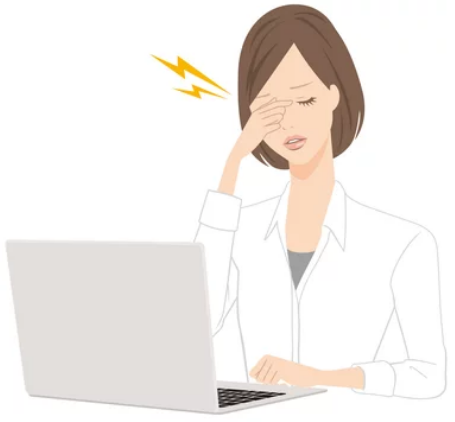
Computers, smartphones, tablets… nowadays we spend more and more of our everyday lives looking at screens. Intensive use presents a real psychological and physical risk, and in particular increased eye fatigue.
The way you organise your workstation can play a key role in preventing eye fatigue and the onset of musculoskeletal disorders.
Eye fatigue occurs after intensive and prolonged strain on the eyes: sustained use of a computer, tablet, smartphone, television and even just reading text on paper (books, magazines, etc.).
Symptoms of this chronic disorder can affect all the parts of the eye. The symptoms, which are easily detectable, are a sensation of heaviness in the eyeballs, redness, tingling, glare, dry eyes, discomfort in far vision (temporary myopia), and even headaches.
Other factors affecting eye fatigue are cigarette smoke, air conditioning (dryness), bright light and dust.
However, eye fatigue is a reversible phenomenon that disappears after rest.
1- Position your computer screen correctly
Align your computer screen with your eyes to prevent eye strain and to reduce neck pain.
It is important when working on a screen to keep a distance of 50 to 70 cm from your eyes (i.e. one arm’s length) with the top of the monitor positioned at eye level. If you wear progressive lenses, test try positioning the monitor slightly lower than your eyes; your eyes will tell you if the position is right for you.
2 – The brightness of your screen
Adjust the brightness of your screen to the lighting in your surroundings. Decrease or increase the brightness of your screen, depending on whether you are in a bright or dark place to avoid glare (brightness: 65-70%, contrast: 85%).
The use of anti-reflective filters is not recommended as they can decrease contrast and interfere with reading. If possible, use blinds or movable curtains to effectively prevent glare.
3 – Perform quick and easy exercises
Working on a screen leads to a reduction in eye blinking which results in the onset of dry eyes. You can avoid this by performing a few exercises:
4 – Take regular breaks
A change of activity and alternating screen work with other tasks can give you a short break from staring at the computer screen and give your eyes a rest.
It’s also important to take 5-minute breaks every hour.
Exposure to blue light caused by screens is a major factor in eye fatigue but there are solutions to relieve it. If the symptoms related to eyestrain persist, we advise you to consult an ophthalmologist to discuss the need to prevent the risk, for example, by correcting your vision with specific glasses.
| Cookie | Type | Duration | Description |
|---|---|---|---|
| cookielawinfo-checkbox-necessaire | 5 months 27 days | This cookie is set by GDPR Cookie Consent plugin. The cookies is used to store the user consent for the cookies in the category "Necessary". | |
| cookielawinfo-checkbox-non-necessary | 5 months 27 days | This cookie is set by GDPR Cookie Consent plugin. The cookies is used to store the user consent for the cookies in the category "Non-necessary". |
| Cookie | Duration | Description |
|---|---|---|
| VISITOR_INFO1_LIVE | 5 months 27 days | This cookie is set by Youtube. Used to track the information of the embedded YouTube videos on a website. |
| Cookie | Duration | Description |
|---|---|---|
| bKlBspUwLtMXRk | 1 day | No description |
| gIYwBGqd | 1 day | No description |
| oL-xblZYKgPh | 1 day | No description |
| pll_language | 1 year | This cookie is set by Polylang plugin for WordPress powered websites. The cookie stores the language code of the last browsed page. |
| qlySmJWZBuQ | 1 day | No description |
| Ubdc+j3wh2CaVVAfrQ__ | 1 hour | No description |
| Cookie | Duration | Description |
|---|---|---|
| YSC | session | This cookies is set by Youtube and is used to track the views of embedded videos. |